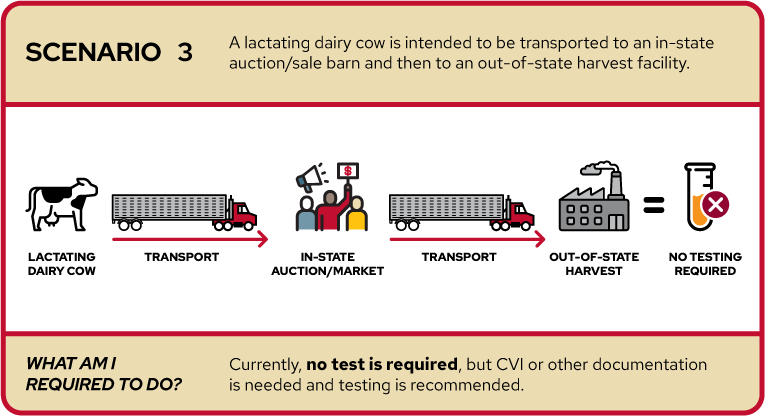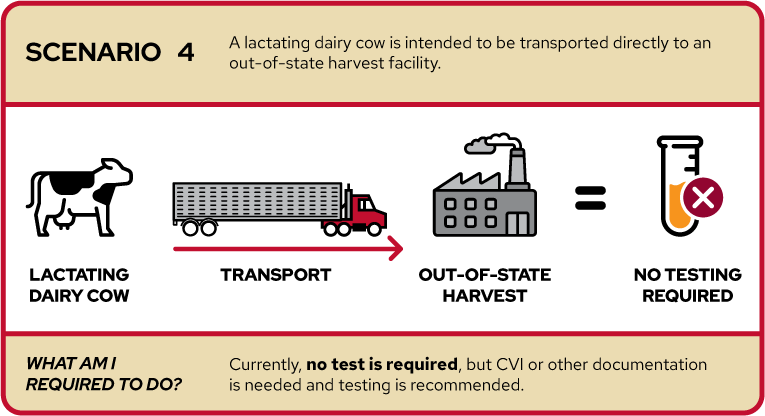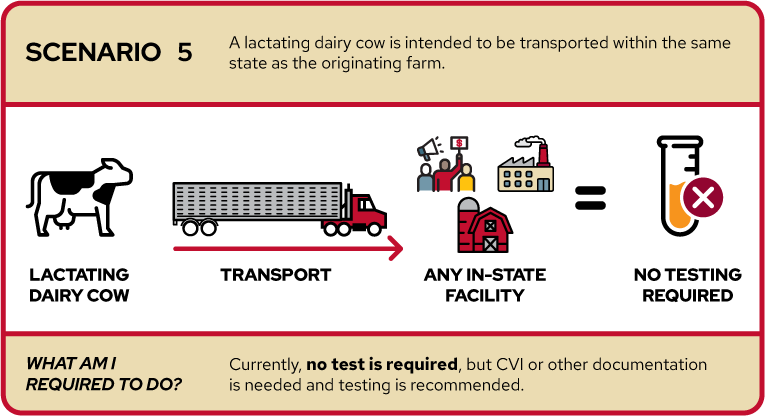Introduction
The Federal order regarding the HPAI (H5N1) virus situation requires testing for specific interstate (across state lines) travel of lactating dairy cattle (put into effect April 29, 2024).
Before interstate movement, lactating dairy cattle are required to receive a negative test for Influenza A virus by milk sample at an approved National Animal Health Laboratory Network (NAHLN) laboratory using an NAHLN-approved assay. Symptomatic (sick) lactating dairy cattle are ineligible for interstate movement or movement to slaughter. Nonlactating dairy cattle – including heifers, dry cows, and bull calves, along with beef cattle – are not currently subject to testing for interstate movement, but testing by nasal swab is strongly encouraged.
Proper planning around sample shipping and testing facility schedules should occur. Dairy farmers should work with their herd veterinarian to navigate this process to ensure sample collection and testing take place no more than 7 days before the transport event.
Each animal should be fit for transport before loading for a transportation journey. Animals should have a Certificate of Veterinary Inspection (CVI) or other documentation of movement approved by the sending and receiving State Animal Health Officials and provided to the sending and receiving State Animal Health Officials. In place of a CVI, an Owner Hauler Statement can currently be used for interstate travel and does not require veterinary approval, but is not accepted by all US states. Individual states can require further action for any transportation situation, please check with your own state’s policies by referencing the state animal health website and/or NMPF’s list of specific state transportation mandates. Sale barns and auction markets may also have their requirements about receiving and marketing dairy cattle that must be adhered to as appropriate. When planning to exhibit dairy cows at cattle shows, please check with show committees on guidelines they have implemented around dairy cows.
Regardless of the type of transportation journey, whether across state lines or not, all cattle showing related signs should be tested. Proactive management and animal monitoring is critical.
Below are scenarios to assist farmers with understanding the Federal order.
Updated: 06/17/2024
Scenario 1
A lactating dairy cow is intended to be transported to an out-of-state farm.
What am I required to do?
The animal is required to have a negative HPAI (H5N1) test before transport.

Scenario 2
A lactating dairy cow is intended to be transported to an out-of-state auction/market. The cow may be sold to another farm or intended for in or out-of-state harvest after marketing.
What am I required to do?
The animal is required to have a negative HPAI (H5N1)
test before transport.

Scenario 3
A lactating dairy cow is intended to be transported to an in-state auction/sale barn and then to an out-of-state harvest facility.
What am I required to do?
Currently, no test is required, but CVI or other documentation
is needed and testing is recommended.

Scenario 4
A lactating dairy cow is intended to be transported directly to an out-of-state harvest facility.
What am I required to do?
Currently, no test is required, but CVI or other documentation
is needed and testing is recommended.

Scenario 5
A lactating dairy cow is intended to be transported within the same state as the originating farm.
What am I required to do?
Currently, no test is required, but CVI or other documentation
is needed and testing is recommended.

Scenario 6
A lactating dairy cow is intended to be transported to an exhibition or fair in Wisconsin.
What am I required to do?
The animal is required to have a negative HPAI (H5N1)
test with samples collected no more than 7 days before transport.

Adapted from Cornell University.
Biosecurity and communication are key
Mindful observation and critical biosecurity practices should be implemented and remain top of mind to identify sick animals and prevent the spread of the disease-related virus. All sectors of the industry, researchers, veterinarians, and farmers must work together during this situation.
More information about HPAI (H5N1), including biosecurity resources, can be found on the UW-Madison Division of Extension Dairy Program Area website (https://go.wisc.edu/HPAI-Resources). Please stay up to date with information as the situation evolves by subscribing to updates from USDA and WI DATCP.
Image Credits
Images are not allowed for any use outside of this Article. Images may not be downloaded or shared. Images created by: Supanut Piyakanont, Juan Pablo Bravo, Nendra Wahyu Kuncoro, P Thanga Vignesh, Meko, Kukuh Wachyu Bias, Adrian Syauqi, and Funtasticon from the Noun Project.
Authors

Aerica Bjurstrom
Regional Dairy Educator – Aerica’s work focuses on herd health and animal welfare. She also has a strong background in meat quality and has done programming in market cow carcass quality.

Jackie McCarville
Regional Dairy Educator – Jackie’s primary focus is dairy operations. She has experience in the private sector in animal nutrition and on dairy farms.

Faith Reyes
Dairy Outreach Specialist – Faith Reyes was a Dairy Outreach Specialist in the Division of Extension at the University of Wisconsin – Madison (2023-2024). Her work aimed to understand dairy farmers’ needs to provide directed, beneficial education programs. She served as a bridge between the novel research taking place at the university level and the dairy industry by communicating research outcomes and applicable on-farm solutions.
Download Article


 Resources for Highly Pathogenic Avian Influenza (HPAI) H5N1 virus in Cattle
Resources for Highly Pathogenic Avian Influenza (HPAI) H5N1 virus in Cattle Strengthening biosecurity practices on dairy farms
Strengthening biosecurity practices on dairy farms Fortaleciendo las prácticas de bioseguridad en granjas lecheras
Fortaleciendo las prácticas de bioseguridad en granjas lecheras  Los terneros también sufren estrés: lo que los productores lecheros necesitan saber
Los terneros también sufren estrés: lo que los productores lecheros necesitan saber


